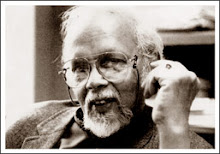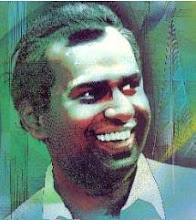Even though in such fields as architecture, sculpture, painting, music and dance, the Tamils of the Peninsula (indeed, the Tamils of Sri Lanka) followed the trends and patterns prevalent in South India, there is one area in which they put their stamp of originality and indiganity: Naddu Koothu or Folk Play. It consists of dancing, acting and musical dialogue inextricably interwoven. Being a "vital element in the community life of the Tamil people," I it reflected in many ways the customs and manners of the people as well as the distinct phases of their social and institutional life. Though it was in a "moribund condition primarily because it has been denied the social status it once enjoyed, by the sophisticated society" 2 Of colonial times, much has been done in recent years to present it as the national heritage of the Tamils of Sri Lanka.
There were various types of Koothu: Vasanthan Koothu, Paraimela Koorhu, Kaman Koothu, Kathan Konthu, Vaciamodi Koothu, Thenmodi Koothu. Among these, the first two consist of singing and dancing without much of a well-knit story; in addition, they were merely repeated in the same form as they were written originally without any change or adaptation Kanurn Koothu focuses on the mythical story of Siva burning Kaman, the god of love, and Kathan Koothu narrates the puranic story of the hero Kathavarayan, a creature of Siva's consort, Parvati. According to Vithiyananthan, who was greatly responsible for making Koothu "modem" and "respectable", "episodes from North Indian Literature are enacted" in Vadamodi or Northern type and "South Indian and indigenous themes" are generally to be found in Thenmodi or Southern types; besides, these two types also have different music, dress and dance forms."
Further, Thenmodi is claimed to be more ancient than Vadamodi which is "akin to the modern dance".
Sillaiyur Selvarajan, a knowledgeable artist and poet, characterizes Thenmodi and Vadamodi in the following manner:
- Vadamodi
- Theme: Hindu epics and puranas
- Stress: Heroism or bravery
- More: Dancing
- Less: Musical Singing
- (New: North Indian Melodies introduced)
- Thenmodi
- Theme: Christian stories
- Stress: Love
- More: Musical Singing
- Less: Dancing
Selvarajan admits that before the advent of Catholicism, Thenmodi depicted Hindu themes, but those scripts are not available today. According to him, in Thenmodi there exist rich variations in singing from region to region, and from the manner in which melodies are sung, one can know the character of the people of a region.
It is important to note that Roman Catholics, who are credited with having preserved and fostered Thenmodi Koothu, made use of this form of art to propagate their religion during the time of the Portuguese and later to safeguard it under the Dutch. Rev. Philippus Baldeus, the Dufch Calvinist Minister, mentions that most churches of Roman Catholics had "scaffolds or theatres" near them where events from the Bible were enacted on holydays.
It is quite possible that the Catholic missionaries who came from Goa and from South India influenced to a great extent the Catholic tradition of Naddu Koothu and hence even the term Thenmodi might be a pointer to the South Indian connection.
Naddu Koothu, which according to many is derived from the
South Indin Therukkuthu, literally Street Play, of South India, was performed originally in the open air and usually on a circular platform, which was raised from the ground with earth or sand. There were no seats, no props and no change of scenes. Oil-torches were the only lighting devices. Actors moved in a circle or moved round about half the circumference in order to make themselves visible to the audience seated round the raised platform and to make themselves heard by it. Instead of the curtains, a piece of cloth was used behind which actors could stand before they were introduced to the audience by the regisseur of the play called annavi.
The staging of Koothu had its social or group dimension and dynamics. It was the collective "ritual" and festival of the entire village where it was held. Relatives of actors, singers and musicians and other people from neighbouring villages were invited to, and were present at, the performance.
There were some usual cernmoies (in many villages) that were connected with the production and performance of a Koothu. The ceremony of casting (for the play) was called saddankoduthal. Those who wanted to take part had to undergo an audition test. Certain roles were reserved for certain families for various reasons. Participants chosen for a role (or roles) were handed their parts written on olas or palmyrah leaves (nowadays on paper) by a person of eminence and respect.
After this initial ceremony, rehearsals went on almost every night for four or five months.
Next followed a ceremony called sathankai, which lasted from morning till late in the evening to which people from neighbouring villages were invited. This ceremony consisted in the wearing of anklets by the actors. This was followed by Kizhamaikkoothu in which actors, wearing the anklets, performed during the day.
Nearly a week before the final performance, the entire play was staged without costumes. This event was called velluduppu.
The day of performance had an air of festival. Crackers were fired and hospitality was extended to all the relatives and friends who had come to see the play from other villages. During the performance, friends and relatives garlanded the actors, pinned notes of cash on their costumes or donated ornaments of gold. After the performance, the entire cast and some spectators went to the temple to dance and sing.
Catholics went to the nearby church to sing a concluding benediction called mankalam.
Often, actors went in a group to houses of their relatives and families of prominence to receive due honour and gifts.
It was also usual for unmarried young men to get married after taking part in such a performance.
In conclusion, the following observations may be made regarding Koothu:
Firstly, the Naddu Koothu of the Tamils of Sri Lanka have preserved the fundamental conception of drama as a dance, namely the representation of a series of actions "through rhythmic motion". Indeed, the expression for dramatic performance in Tamil - nadagam adinan or koothu adinan -, which means he danced the play, aptly connotes the essence of theatre as traditionally understood by Tamils.
Secondly, Naddu Koothu has many elements of symbolic theatre. Many actions and settings may be and are mimed. "Consequently dramatists need not always look to the West for inspiration about pure or total theatre.
Thirdly, though most of the themes and stories of Naddu Koothu were and still are religious and moral in character, reflecting perhaps the didactical nature of Koothu, one need not do away with or even minimise the perennial value of such general and universal themes in favour of touching the "needs of the present society". This means that themes affecting the present should be developed without abandons the age old ones"
Fourthly, though Naddu Koothu was usually associated with people from lower strata of society earlier and "has necessarily been practiced in isolation", a new awareness has dawned in the last few years that it is neither Bharata Natyam nor Kathakali but Naddu Koothu which is the cultural heritage of the Tamils of Sri Lanka.




































No comments:
Post a Comment